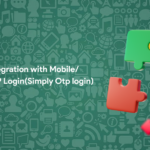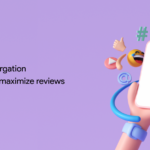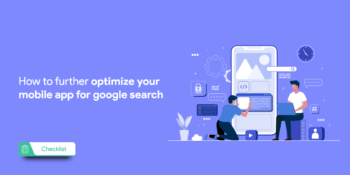The WHO estimates that there are 1 billion persons worldwide who are disabled. That amounts to about 15% of the world’s population.
You must concentrate on making your mobile app “accessible” if you don’t intend to ignore this enormous pool of prospective users. When you do that, your app will be able to reach a larger audience, which will increase download rates and ultimately boost your revenue.
However, this is merely the very beginning. There are numerous further justifications for why you should prioritise accessibility while creating your app. We’ll explore those reasons in more detail later on in this blog , but first, let’s clarify what we mean by “mobile app accessibility.” This can be you go-to mobile app accessibility checklist.
What does accessibility in mobile apps mean when creating mobile apps?
Designing applications for smartphones, tablets, and wearables must adhere to a set of recognized best practices known as accessibility for mobile apps. The objective of accessibility on mobile devices is simple: to make sure that your software can be utilized by millions of individuals with disabilities worldwide. The following are some forms of disabilities to take into account while creating a mobile app:
Visual impairment: This condition can range from the inability to discern some colors to total blindness.
Hearing impairment can range from the inability to hear sounds at certain frequencies to total deafness.
Cognitive impairment makes it difficult for users to follow or comprehend a number of features or components in an app.
Mobility-related problems – Prevents users from navigating the app using intricate taps, swipes, and gestures.
Learning-related problems – Also known as invisible disabilities, these problems are mainly caused by users’ low literacy rates or technological difficulties.
Why should you make your mobile app accessible?
Now that you are aware of what we mean by mobile accessibility, let’s examine the several factors that demand your attention.
Everyone can utilize your app
You are “morally compelled” to focus on mobile accessibility, and this is perhaps the easiest justification for doing so. In other words, you must make sure that everyone in the globe has an equal opportunity to benefit from or utilize your good or service as a responsible member of the global community. People shouldn’t avoid using your software because of mental or physical impairment. In short, an accessible mobile app contributes to the development of a more equitable society in which persons with disabilities are not denied the advantages of digital tools.
Better brand perception
Making your mobile application available to anyone sends a powerful message to the world about your brand:
- This keeps users in the spotlight.
- That gives everyone on the earth open access to their goods or services.
- The user’s journey will be made as comfortable as possible by that at any cost.
Users will spread the word about such a brand once they become aware of it. They will heavily promote your app in their network. Positive word-of-mouth advertising and rising brand recognition within your target market will have you scaling up quickly.
Limit the chance of accessibility-related litigations
According to the Title III of the Americans with Disabilities Act (ADA), you are prohibited from discriminating against anyone on disability grounds. It also states that they (people with disabilities) must have full and equal rights to access all the goods, services, facilities, privileges, etc., that are enjoyed by the rest. So unless you want to spend years fighting litigations in court, you need to make sure that your app is accessible to everyone.
Gain a competitive advantage
Only 29% of paid Android applications and 35% of paid iOS apps have passed accessibility testing, according to Diamond’s third annual State of Accessibility Report. In other words, the majority of your rivals have not yet made their apps available to those 1 billion users. This gives you a significant competitive advantage and the ability to reach those audiences first.
How can you make your mobile application accessible?
Here are a few strategies for embracing mobile accessibility.
Color contrast: The WCAG (Web Content Accessibility Guidelines) recommends that you maintain a contrast ratio of at least 4:5:1 between the text and backdrop. When you keep this ratio, the text will be simple to read even for people with limited colour vision.
Audio descriptions: Make sure to include audio descriptions for each piece of visual content that is available in your app. People with visual impairments will be better able to grasp what you are trying to say to the users if you follow this best practise.
Labels: There are various screen readers that assist people with visual impairments by reading out the information of an app. Because of this, it’s crucial to name all of your buttons, text boxes, and other items that can be clicked in order for the screen reader to function properly. A logo, graphic element, or image should not be added to an element as this may interfere with the screen readers’ ability to do their jobs. If necessary, you can add the labels in a way that makes them visually invisible but yet allows a screen reader to read them.
Gesture: Users only navigate across apps using gestures like taps and slides. Because of this, it is crucial for an app developer to pay attention to these features and make sure the app is user-friendly for everyone. For instance, you need to make sure that all of the app’s features are accessible with only a single finger press. For people with motor disabilities, many taps, complicated scrolling, or pinching can be challenging.
Because adopting mobile accessibility requires time, money, and resources, many app owners and developers choose to ignore the issue. They consider it to be an extra feature. This is a HUGE error. Any mobile app must adhere to mobile app accessibility standards; it is essential. It offers a variety of advantages that you can start taking use of right now by implementing accessibility-related features, as you have seen in this piece.
Try Appmaker if you haven’t begun developing your app yet and are unsure where to begin. We are a quick app builder that can assist with creating your accessible app in a matter of time.









No Comments
Leave a comment Cancel